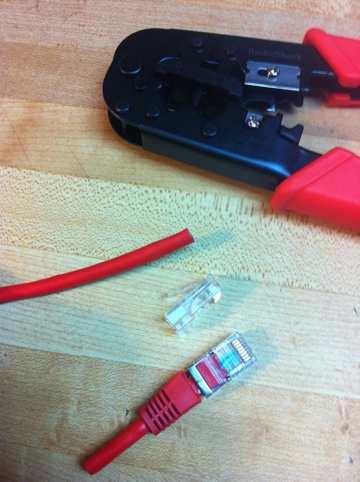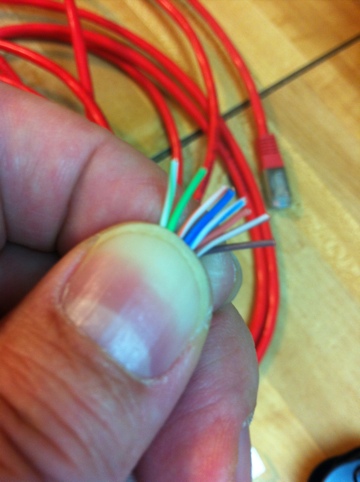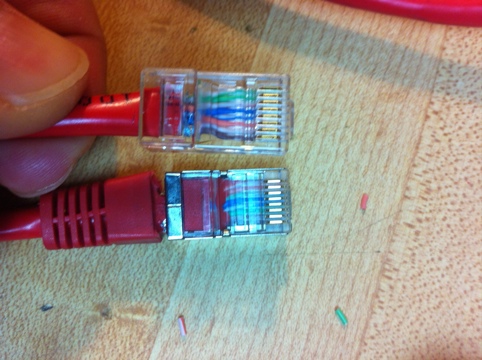I have a very long ethernet cable that had broken connectors.
It was time to make a change.
I have had a cable crimper and tool for a long time and some connectors.
Hack off the bad connector.
In examining the cable carefully I realized that this was a cross-over not a straight-through cable. I wanted a cross-over cable. No power-over-ethernet stuff to worry about. What this meant, however, is that once I did one end of the cable, I had absolutely to do the other end as well to be sure. The straight and the cross-over have a different order of the little wires.
Untwist the twisted pairs. Which… now that I think of it… is a good slogan for the present day culture wars.
Got them into the right order and them trimmed them down to the right length.
Stuck them into the crimper and, well, crimped ’em.
Yes, indeed, I need to do the other end too. Sip some Mystic Monk Coffee (it’s swell!) and repeat the process.
I don’t have an ethernet cable tester, but I carefully double-checked the order of the wires. It works just fine.
I have spool of cat-5, some connectors, a crimper. Ready to go.
Need cables? Do it yourself.






































Huzzah!
Way to go, Father!
Saves you time and a lot of money.
Looks like a good job, Fr. Z… If I may volunteer a recommendation as a professional network engineer, always be sure to get right kind of RJ45 “plugs” on each end. There is one kind for flat cable (less common these days) and another kind for round cable. Also, there is one kind for stranded and another for solid wire. This is very important. [Ah… good.] The prongs in the stranded RJ45 connector go into the middle of the strands, whereas the prongs in the solid connector form a sort of V in which the solid wires sit. If you use the stranded connector on solid wire, the prong will curl up against the wire, you won’t have a good connection, and you will have a flaky cable. I see this all the time with homemade cables. However, I’m sure the years of reading Latin have given you superior attention to detail, and you would never miss something like this. I am simply posting this advice for readers who might be tempted to go off crimping their own cables.
You appear to have a decent crimping tool. The inexpensive ones are only good for making a few crimps until they become worn and unusable.
This might seem like an arcane knowledge necessary only for those few computer geeks out there, but good ethernet cables are essential with the increase in broadband Internet access. By knowing how to do this, and it’s not hard, you can save a bunch of money if you want to have wired Internet access in another room away from your DSL or cable Internet router.
I learned how to do this about 10 years ago, and have used it regularly since. Even helped wire up a dorm at my college seminary.
@Mark: I have the same one from “the Rat Shack”, and it does seem to be a good one. Very solidly built.
jeffmcl: Very diplomatic! Thanks for those tips.
I think in the immediate future I am going to make a review of my whole network and all the cables and all the various types of devices and make sure I have the right cables and connectors.
For example, the sort of cable best to link my DSL router to the first switch (pretty sure you need a straight-through), the best cable to use between the switch and, say, a computer (straight-through), a Sling Box (straight-through), another switch (cross-over), etc.
Cables aren’t just cables, after all!
You are the coolest priest ever! Swellest? I’m so glad I found this blog- though my husband laughs at me for being addicted to it. Ha! We’ll see who laughs now when I show him this. ;)
thanks Fr Z!
Yes, it’s not hard to learn, and it pays off… I made a good number of cables when I was the “computer guy” in the seminary where I was teaching philosophy. I also saw a lot of home made cables that were badly done, though. It’s not hard to do it right, but you do have to have some idea of what you are doing – as Fr Z obviously does!
Very nice job.
Fr Matthew: QBDBD!
Once you know that there are different kinds of cables for different purposes, you are most of the way there.
Sometimes, Father, I think that your talents are wasted as a priest!!!
Another detail worth knowing is that CAT 5 won’t work reliably with a gigabit network switch. For gigabit, CAT 5e or CAT 6 is necessary. Crimping cables is fun after I look at the typical retail price of a new cable in Best Buy or Staples (though Home Depot is lots better on pricing). I hate throwing things away if they are repairable. We need to take after our Creator; imagine if he gave up on us after we made our first mistake.
Crimping your own cables won’t last much longer as network speeds continue to increase. You can make a Gigabit Cat 5e patch cord, but Cat 6 and Cat 6A patch cords require very careful twisting and crossing of the pairs, very tight tolerances, and special molded connectors to meet specifications. The reason is that Cat 6 and 6A are specified to higher frequencies and have more stringent crosstalk requirements (untwisting a twisted pair increases the crosstalk, which is why when you make your own cables, you should untwist the pairs as little as possible).
Thanks Father, I’ve been wanting to know how to do that for a while!
But how much is the cable crimper?
Andrew–Interestingly, the IEEE standard for Gigabit Ethernet over copper (802.3ab) specifies Category 5 cable as the minimum, not 5e, so hand crimping Cat 5 cables will work. Because the speeds are greater, however, there is less tolerance for improperly installed Cat 5 than previous versions of Ethernet, so Obumbrabit’s advice about not untwisting too much is sound…
Most new switches auto sense whether you are using a crossover or straight-thru cable, or have an ‘uplink’ port (on the smaller switches) on which a straight-thru cable can be used. This has largely negated the need to have both types of cables lying around. Of course there will always be the exception, depending on the age and vendor of the switches. I use no crossover cables in my home network, unless I want to do gigabit ethernet, at which point I use a crossover directly between 2 workstations for those really big file transfers. One of these days I’ll invest is a gigabit switch. ;)
I will echo Obrumbabit’s urging to do as little untwisting as possible as this can introduce noise at gigabit speeds. Also, using stranded for drop cables is preferable since it is less likely to have a complete break on any given single wire. Solid wire is used, typically, on building riser cable which shouldn’t move very often. At gigabit speeds all 4 pairs are used, so getting the pairs correct is pretty important.
Crimping cables is an amazing way to save money. I too get sticker shock when looking at the price of ethernet drop cables at the big box stores. However, check out amazon for cables. I’ve seen some pretty amazing prices for all types of cables, ranging from optical audio to ethernet cables. I’m sure none of this stuff is made in the States, but the prices are a fraction of what you would buy at the store and, oh, and those are made overseas too.
Way to go. We make up cables in our pipe organ shop quite often.
Keep in mind that while “lining up the colors on both ends” works for most people, it is not proper. There are two standards for the arrangement of the copper pairs in a patch cable. 568A and 568B. 568B is technically superior, but it is not backwards compatible with phone networks.
The copper pairs in a patch cable are arranged in specific order. Each pair (two color coded wires, one solid, one with a stripe, both of the same color) is twisted inside of the PVC case. The twist applied to each pair is different. This was done to minimize crosstalk, interference from nearby pairs.
When the wires in each pair are not ordered properly the amount of crosstalk increases the longer the cable. This will lower the total bandwidth of the cable. The other posters point about tolerences at each end also holds true. Any more than 1/2″ of straightened wires on either end will cause a significant amount of crosstalk at each end. This is called near-end and far-end cross talk.
A cable that follows 568B standards would have the pairs arranged as follows:
White Orange
Orange
White Green
Blue
White Blue
Green
White Brown
Brown
These would be arranged from left to right when looking at the side of the connector with the gold pins facing up and away from you.
If you are making a crossover cable (This is where the transmit/receive wires are swapped on one end. Usually used to connect two devices without a switch) you would swap pins 1/3 and 2/6.
Here is a good visual overview : http://www.lanshack.com/make-cat5E.aspx
Not my site, just good info.
I do network engineering for my company and am glad I am NOT doing this for any length of time. It is VERY time consuming. I only use Panduit products so these are ends that I use:
http://www.panduit.com/groups/MPM-OP/documents/InstallationInstruction/105755.pdf
You CAN make a professional/commercial connector yourself if you use the proper tools. Barring that, just follow the 568B spec to have less cable related networking issues.
A good crimping tool costs more than two or three cables, usually. Unless you think you’ll need several, rolling your own is uneconomical.
Orange stripe – orange – green stripe – blue – blue stripe -green – brown stripe – brown.
I don’t think I’ll ever forget that after doing about 1000 terminations. Always make sure to look at the end of the connector and see 8 little eyes looking back out at you :)